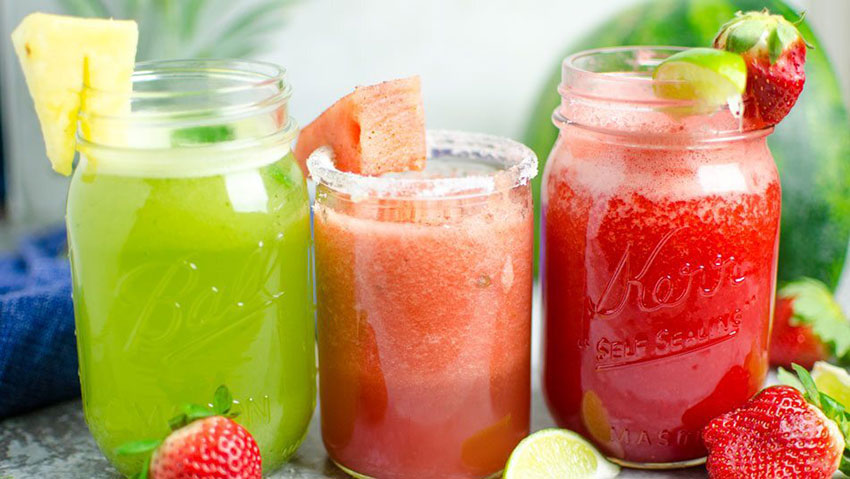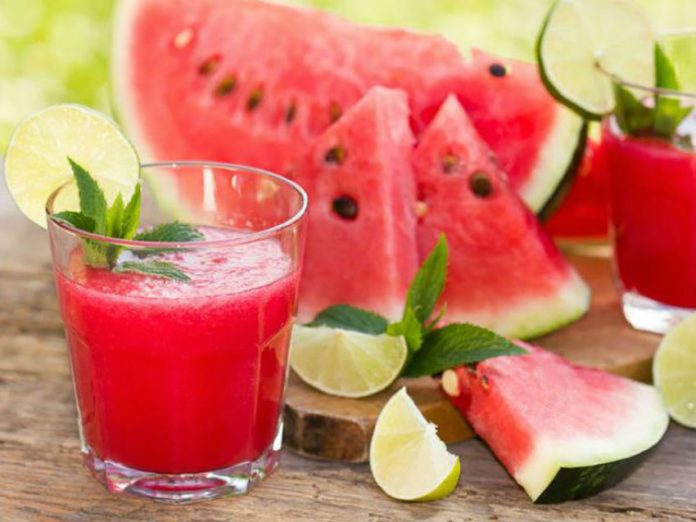Nothing says Mexico like jars of colorful agua fresca lined up on a counter or street cart! Tasty, refreshing and often surprising, these simple fruit drinks are a tried-and-true standby for living in a tropical climate. They’re a good use of ripe fruit and make staying hydrated — especially during the hot summer months — easy, inexpensive and delicious.
Most people know that agua fresca — literally “fresh water” — isn’t just juice. Made from fruit that’s first puréed and then strained (más o menos) to get rid of the pulp, sweetened with a little (or a lot!) of sugar and mixed with water, agua fresca is traditionally served icy-cold from big glass jars filled with ice. Sometimes a little lime juice or fresh herbs like mint or basil (albahaca) are added.
The most common flavors are piña (pineapple), melón (cantaloupe), berry, sandía (watermelon), mango, limón (lime), fresa (strawberry), guava, tuna or almost any combination thereof. Just about any ripe, juicy fruit can be used to make agua fresca, as well as tamarind and jamaica (hibiscus flowers), which I wrote about in a previous column.
Those are a very different process, and while they’re commonly called and sold as agua fresca, they’re really more like iced teas. You’ll also find more contemporary versions featuring unusual combinations like celery, beets, carrots and even chia seeds for a protein boost.
While these are simple to make, there are a few “tricks of the trade.” Dissolving almost any kind of sugar in cold water takes more time and patience than you might have, so think about making a simple syrup or dissolving the sweetener in a little hot water before adding it to the rest of the drink. Especially if you’re using piloncillo, even grated, you’ll probably want to dissolve it in warm water first.

Very ripe fruit that smells sweet will make the best-tasting agua fresca. Fresh coconut water can be added to any agua fresca where you think the flavors combine well; if you use canned, be sure it’s coconut water, not coconut milk, which is an entirely different thing.
And a couple of teaspoons of fresh lime juice will brighten the taste of almost every fruit. Most agua frescas will last five to six days in the refrigerator.
Watermelon (Sandía) Agua Fresca
- 4 cups cubed, seeded watermelon
- 2+ cups water
- ¼ cup sugar
- Lime slices or strawberries for garnish
Purée watermelon, sugar and 1 cup water in a blender till smooth. Pour into pitcher. Add remaining water. Pour over ice and serve.
Basic Agua Fresca Recipe
- 4 cups cold water
- 2 cups fresh fruit
- ¼ cup sugar (or equivalent other sweetener)
- Optional: 2 tsp. fresh-squeezed lime juice
- Ice
In a blender or food processor, purée water and fruit until smooth. Strain through a sieve, add sugar, mix well and pour into pitcher. Serve chilled over ice.
Cantalope (Melón) Agua Fresca
- 4 cups cold water
- 1 cantalope
- ¼ cup sugar
Seed and peel melon and cut into chunks. Purée in blender or food processor till smooth, then strain well. Discard pulp. Put water, sugar and cantaloupe juice in pitcher and stir well to combine. Chill and serve over ice.
Limón Agua Fresca con Chia
- 1 tsp. chia seeds
- 2 cups of water
- 3-4 Tbsp. fresh lemon or lime juice
- 2 tsp. sugar
- Fresh basil or mint leaves
Make limonada by mixing the juice, water and sweetener. Add chia seeds and stir. Let sit for about 15 minutes, stirring occasionally. Seeds will absorb the water and soften to a pleasantly gelatinous state.
Note: To make a bigger batch, use 6 cups of water, 6 big lemons or 10 limes (to make ½ cup of juice), ¼ cup sugar, 2 Tbsp. chia. Follow directions above.
Agua de Tamarindo
It’s not that hard to make this from scratch. Or just buy a jar of tamarind pulp.
- 15 dried tamarind pods
- 2 quarts water
- 1 cup sugar
Bring half the water to a boil in a large pot. Prepare the tamarind pods by removing the brittle outer shell and pulling off as many strings as you can; discard shells and strings.
After water comes to a rolling boil, remove from heat and add the inner portion of the tamarind and the sugar to the water. Let sit for about 1½ hours. Using your fingers, squeeze the liquid out of the hard tamarind seeds, remove any remaining strings and discard both seeds and strings. Place the liquid and remaining pulp in a blender or food processor and process until pulp and water are fully combined. Strain the liquid through a strainer or leave it pulpy. Pour into a pitcher, add remainder of the water, and refrigerate until cold. –thespruceeats.com
Agua de Piña
- 1 pineapple
- 1/3 cup sugar
- 5 cups cold water
Peel, core and cut pineapple into chunks. You should have about 4 cups. Pour sugar over pineapple chunks and let sit for 20-30 minutes. Pour into blender with 1½ cups cold water and mix until combined. Strain through a sieve, scraping with a spoon to help all the juice get through. Discard pulp. Pour into pitcher and add remaining water. Stir and adjust sweetener if needed. Refrigerate and serve over ice.
Janet Blaser has been a writer, editor and storyteller her entire life and feels fortunate to be able to write about great food, amazing places, fascinating people and unique events. Her first book, Why We Left: An Anthology of American Women Expats, is available on Amazon. Contact Janet or read her blog at whyweleftamerica.com.
